<< Previous | Displaying results 6026-6050 of 6769 for "" | Next >>
One of the many Jewish schools established by the Joint Distribution Committee in central and eastern Europe for children who had lost their parents during World War I. Rovno, Poland, after 1920.
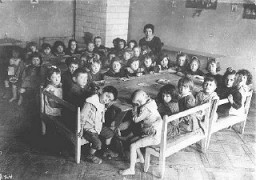
Women and children gather at the door of a soup kitchen maintained by the American Jewish Joint Distribution Committee. The text in Yiddish reads "The fortunate ones with full bowls." Zelechow, Poland, 1940.
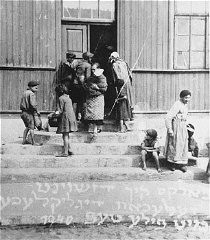
William Bein, director of the American Jewish Joint Distribution Committee (JDC) in Poland, with children at the Srodborow home for Jewish children, near Warsaw. The home was financed by the JDC. Srodborow, Poland, 1946.
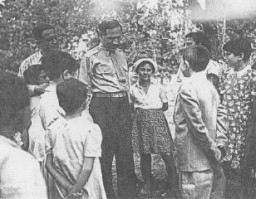
US Army and Joint Distribution Committee (JDC) representatives distribute milk to refugees. Vienna, Austria, October 26, 1945.
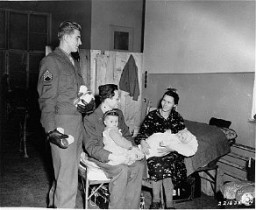
Harry Weinsaft of the American Jewish Joint Distribution Committee gives food to a young Jewish refugee. Vienna, Austria, postwar.
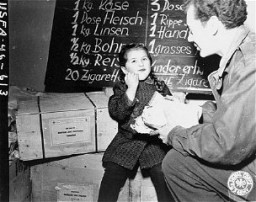
Boxes of matzah in a Joint Distribution Committee warehouse before distribution to Jewish survivors in displaced persons camps. Place uncertain, postwar.
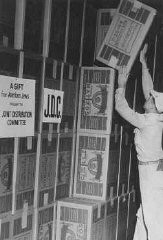
A Jewish youth on an agricultural training farm that prepared Jewish refugees for life in Palestine, sponsored by the Joint Distribution Committee. Fuerth, Germany, June 13, 1946.
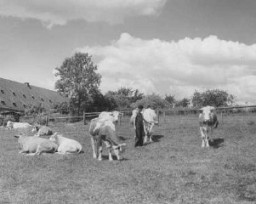
An agricultural training farm to prepare Jewish refugees for life in Palestine, sponsored by the Joint Distribution Committee. Fuerth, Germany, June 13, 1946.

Jewish youth attend a class on transplanting seedlings, part of a general course in farming sponsored by the American Jewish Joint Distribution Committee at the Bergen-Belsen displaced persons camp. Germany, August 1, 1946.
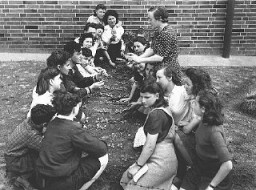
The American Jewish Joint Distribution Committee pharmacy in the displaced persons camp at Bergen-Belsen. Germany, August 14, 1947.

Jews interned in Cyprus prepare for Passover with supplies provided by the American Jewish Joint Distribution Committee. Cyprus, after 1945.
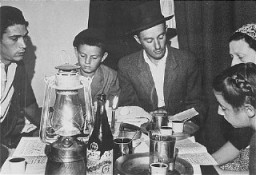
Morris Laub (right), American Jewish Joint Distribution Committee director for Cyprus, reviews supplies sent for the 12,000 Jews still interned on the island. Cyprus, December 9, 1948.
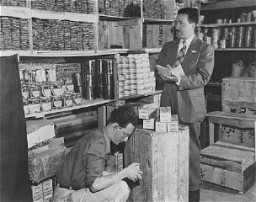
The ruins of a synagogue destroyed by the Germans in 1943. The synagogue, originally built in 1853, was rebuilt after the war with the help of the American Jewish Joint Distribution Committee. Volos, Greece, 1944.
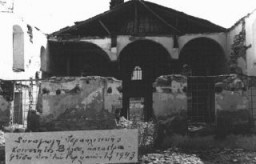
Prisoners from Austria, marked with triangles and identifying patches, in the Dachau concentration camp. Germany, April 1938.
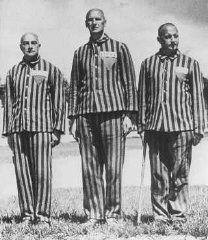
Photograph of Julian Noga, a Polish prisoner (marked with an identifying patch bearing a "P" for Pole) imprisoned in the Flossenbürg concentration camp. Germany, between August 1942 and April 1945.
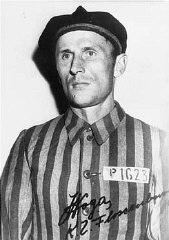
The St. Louis, carrying German Jewish refugees denied entry into Cuba and the United States, arrives in Antwerp. Belgian police guard the gangway to prevent passengers' relatives from boarding the ship. Belgium, June 17, 1939.
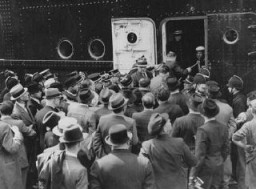
Dr. Robert Ritter talks to several residents in a Zigeunerlager ("Gypsy camp"). Hamburg, Germany, 1940. During the Nazi era, Dr. Robert Ritter was a leading authority on the racial classification of people pejoratively labeled “Zigeuner” (“Gypsies”). Ritter’s research was in a field called eugenics, or what the Nazis called “racial hygiene.” Ritter worked with a small team of racial hygienists. Among them were Eva Justin and Sophie Ehrhardt. Most of the people whom Ritter studied and…
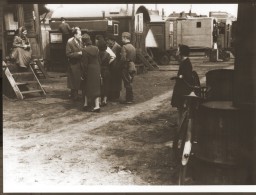
Sophie Ehrhardt, a German hygienist working with Dr. Robert Ritter, performs a racial examination on a Romani woman. Berlin, Germany, c. 1936-1940. During the Nazi era, Dr. Robert Ritter was a leading authority on the racial classification of people pejoratively labeled “Zigeuner” (“Gypsies”). Ritter’s research was in a field called eugenics, or what the Nazis called “racial hygiene.” Ritter worked with a small team of racial hygienists. Among them were Eva Justin and Sophie Ehrhardt. Most…
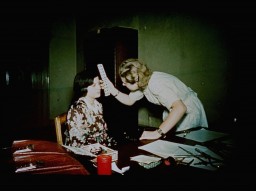
Dr. Robert Ritter and Eva Justin examine a young boy interned in a Zigeunerlager (“Gypsy camp”). Cologne, Germany, c. 1937-1940. During the Nazi era, Dr. Robert Ritter was a leading authority on the racial classification of people pejoratively labeled “Zigeuner” (“Gypsies”). Ritter’s research was in a field called eugenics, or what the Nazis called “racial hygiene.” Ritter worked with a small team of racial hygienists. Among them were Eva Justin and Sophie Ehrhardt. Most of the people…

The “Gypsy camp” in Hodonín u Kunštátu (Hodonin bei Kunstadt), Protectorate of Bohemia and Moravia (Czech Republic), 1942.
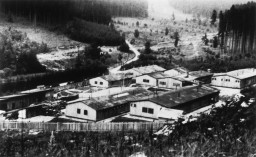
Otto Perl poses with his US Army unit at Camp Ritchie, Maryland, circa 1945. Born in Austria, Perl served in the Austrian Army until March 1938, when he was dismissed because he was Jewish. With the help of a friend, Perl was able to obtain a US visa. He reached New York in 1940. Several thousand of the soldiers who trained at Camp Ritchie were Jewish refugees who had immigrated to the United States to escape Nazi persecution.
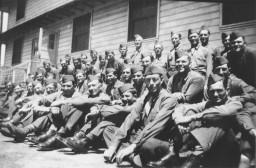
Two American soldiers cross the Rhine River into Germany on March 29, 1945. In the foreground is Jack Caminer, who emigrated from Germany to the United States in 1938. After he was drafted into the US Army, Caminer was sent to Camp Ritchie to prepare for intelligence work. Caminer participated in the liberation of Ohrdruf.
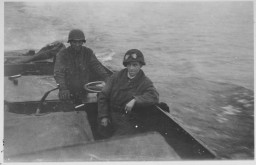
SS men guard Soviet prisoners of war doing forced labor near the Babyn Yar killing site. The photograph was taken within days of the mass murder of over 33,000 Jews on September 29-30, 1941. Kyiv (Kiev), German-occupied Soviet Union, after September 30, 1941.
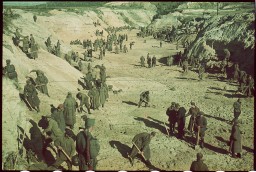
An SS guard speaks with local Ukrainian women while Soviet prisoners of war carry out forced labor. A German Propaganda Company photographer took this image shortly after the SS murdered over 33,000 Jews on September 29-30,1941 at the nearby Babyn Yar killing site. Kyiv (Kiev), German-occupied Soviet Union, after September 30, 1941.
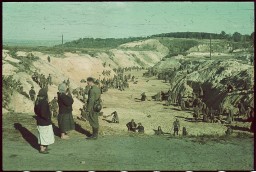
Belongings of a Jewish family murdered by an SS mobile killing squad at Babyn Yar. On September 29-30, 1941, the SS killed more than 33,000 Jews from Kyiv (Kiev). A German Propaganda Company photographer took this image within days of the massacre. Kyiv, German-occupied Soviet Union, after September 30, 1941.

We would like to thank Crown Family Philanthropies, Abe and Ida Cooper Foundation, the Claims Conference, EVZ, and BMF for supporting the ongoing work to create content and resources for the Holocaust Encyclopedia. View the list of donor acknowledgement.